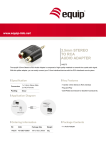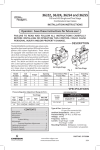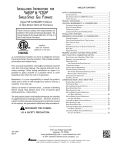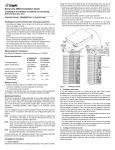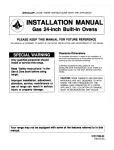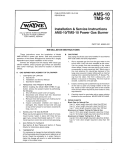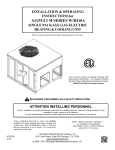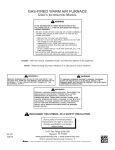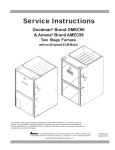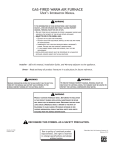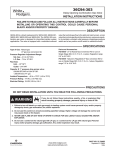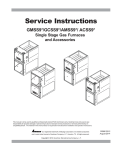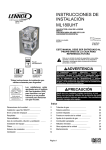Download White Rodgers 36G22-254 Installation Instructions
Transcript
36G22, 36G23, 36G24 & 36G52 36J22, 36J23, 36J24 & 36J52 DSI and HSI Single Stage Combination Gas Valve INSTALLATION INSTRUCTIONS Operator: Save these instructions for future use! FAILURE TO READ AND FOLLOW ALL INSTRUCTIONS CAREFULLY BEFORE INSTALLING OR OPERATING THIS CONTROL COULD CAUSE PERSONAL INJURY AND/OR PROPERTY DAMAGE. DESCRIPTION The 36G/J22, 36G/J23, 36G/J24 and 36G/J52 combination gas valves are designed for direct spark ignition (DSI) and hot surface ignition (HSI) system applications.These valves are equipped with redundant and main solenoid valves that control gas flow to the main burners, a pressure regulator and a two-position on/off switch for regulation and electrical shut-off of the solenoid valves. The 36G/J23, 36G/J24 and 36G/J52 are also equipped with a slow-opening pressure regulator for softer lighting characteristics. 36G 36J SPECIFICATIONS Type of Gas: Natural gas LP gas (use conversion kit) Pressure Regulator Setting: Nat. Gas – 2.5 to 5.0" W.C. LP Gas – 7.0 to 12.0"W.C. Ambient Temperature: -40° to 175°F Pressure Rating: 14" W.C. (1/2 PSI) max. Voltage: 24 VAC Frequency: 50/60 Hz Current: .360 amps Mounting Positions: Multipoise – Control may be mounted in any position. PIPE SIZES/CAPACITIES Pipe Sizes Available (inches) 1/2" x 1/2" NPT any combination Capacity (BTU/hr) at 1” pressure drop across valve AGA Std. Nat. Gas LP Gas (1,000 BTU/cu. ft.) (2,500 BTU/cu. ft.) 140,000 226,800 Parts and Accessories: CONTENTS Description ........................................................ 1 Specifications .................................................... 1 Precautions ....................................................... 2 Installation ......................................................... 3 System Wiring Adjustment ........................................................ 4 Pressure Regulator Adjustment Lighting Instructions ........................................... 5 Notes ................................................................... 6 F92-0656 - LP to Natural Gas Conversion Kit for use on Single Stage 36C, D, E, F, G, H, J valves. Regulation range 2.5" to 5.0" W.C. F92-0659 - Natural to Regulated LP Gas conversion Kit for use on Single Stage 36C, D, E, F, G, H, J valves. Regulation range 7.0" to 12.0" W.C. F92-1003 - Adapter Kit for the 36G Gas Valves. Kit includes: Connector (5/16" to 1/4" hose barb), tube (5/16" O.D.) and Hex Wrench (3/32"). PART NO. 37-6159G www.white-rodgers.com www.emersonclimate.com Replaces 37-6159F 1023 PRECAUTIONS DO NOT BEGIN INSTALLATION UNTIL YOU READ THE FOLLOWING PRECAUTIONS. ! WARNING If you do not follow these instructions exactly, a fire or explosion may result, causing property damage, personal injury or loss of life. 3. NEVER USE FLAME OR ANY KIND OF SPARK TO CHECK FOR GAS LEAKS–COULD CAUSE FIRE AND/OR EXPLOSION. 1. Failure to turn off electric or main gas supply to heating system could cause personal injury and/or property damage by shock, gas suffocation, fire, and/or explosion. 4. Do not use a control set for natural gas with LP gas, or a control set for LP gas with natural gas. Personal injury and/or property damage, gas suffocation, fire, and/or explosion may result. 2. Do not use this control on circuits exceeding specified voltage. Higher voltage will damage the control and may cause shock or fire hazard. ! CAUTION 2. This control is not intended for use in locations where it may come in direct contact with water. Suitable protection must be provided to shield the control from exposure to water (dripping, spraying, rain, etc.). 1. Do not short out terminals on gas valve or primary control to test. Short or incorrect wiring can cause equipment damage, property damage, and/or personal injury. 2 INSTALLATION 1. Turn off electrical power to the system at the fuse box or circuit breaker. Also turn off the main gas supply. 2. If replacing an existing valve, disconnect all plumbing and electrical connections from the old control. 3. The control may be installed in any position.The arrow on the bottom plate indicates the direction of inlet gas flow. 4. You should use new pipe that is properly chamfered, reamed, and free of burrs and chips. If you are using old pipe, be sure it is clean and free of rust, scale, burrs, chips, and old pipe joint compound. 5. Apply pipe joint compound (pipe dope) that is approved for all gases, only to the male threads of the pipe joints. DO NOT apply compound to the first two threads (see fig. 2 for typical piping connections). 6. If you are using a vise or open-end wrench to hold the valve while installing piping, do not tighten excessively, as this may damage the valve (Torque: 375 in-lb maximum). Do not cross-thread during installation as this may damage the valve. 7. See SYSTEM WIRING when making electrical connections. After all gas and electrical connections are completed, turn gas on and check for gas leaks with leak detection solution or soap suds. Bubbles forming indicate a leak. SHUT OFF GAS AND FIX ALL LEAKS IMMEDIATELY. SYSTEM WIRING REFER TO AND FOLLOW THE APPLIANCE MANUFACTURER’S WIRING DIAGRAM. REFER TO FIG. 1 FOR TERMINAL IDENTIFICATION. NOTE All wiring should be installed in accordance with local and national electrical codes and ordinances. Always check that the electrical power supply used agrees with the voltage and frequency shown on the gas control. Outlet Pressure Boss Regulator Vent Regulator Adjust Inlet Pressure Boss (opt.) Terminals On/Off Switch 24 VAC Input (.250" terminal) Electric “ON/OFF” Switch Main & Redundant 24 VAC Input (.250" terminal) Figure 1. Gas valve wiring diagram NOTE All piping must comply with local codes, ordinances, and/or national fuel gas codes. NOTE: A MANUAL SHUTOFF VALVE MUST BE INSTALLED WITHIN 6 FEET OF THE EQUIPMENT NOTE: ALWAYS INCLUDE A DRIP LEG IN PIPING Drop Drop Horizontal 3 in. minimum Piped Gas Supply Horizontal Gas Valve Riser Gas Valve 3 in. minimum Riser Piped Gas Supply Figure 2. Typical gas valve piping 3 3 in. minimum Tubing Gas Supply Gas Valve ADJUSTMENT Always adjust regulator to provide the correct pressure according to the original equipment manufacturer's specifications listed on the appliance rating plate. Replace regulator cover screw and tighten securely. PRESSURE REGULATOR ADJUSTMENT Controls are shipped from the factory with the regulator set as specified on the control label. Consult the appliance rating plate to ensure burner manifold pressure is as specified. If any other outlet pressure is required, follow instructions below. Check for Leaks: Using a leak detection solution or soap suds, check for leaks at pressure boss screw or pressure tap plug. Bubbles forming indicate a leak. SHUT OFF GAS AND FIX ALL LEAKS IMMEDIATELY. Outlet Pressure Adjustment Range: Nat Gas 2.5" - 5" Outlet Pressure Regulator Adjust Tower LP Gas 7.0" - 12" Inlet Pressure Tap Boss Valve Inlet Outlet Pressure Regulator Adjust Tower NOTE Valves cannot be adjusted outside these ranges for the specified gas type. 36G/36J Pressure Testing Ports. (See Figure 3) Model Testing and Inlet/Outlet Pressure Adjustment Outlet Pressure Tap Boss 36J22-214 36G24-214/ 36J24-214 36G54-214/ 36J54-214 5/16" O.D. Pressure Tap Bosses with 3/32" Hex Valve Inlet 1/8” NPT Inlet Pressure Tap Pressure Tap Boss Style Plugged 1/8” NPT Thread Tap Style 1/8” NPT Outlet Pressure Tap Figure 3 Pressure port and regulator adjust locations No need for separate fitting to check pressure 36G55-214/ 36J55-214 36J24-614 36J55-614 Plugged 1/8" NPT Threaded Pressure Taps 5/16” Hose Turn off all electrical power to the system to connect manometer hoses. Hose on Outlet Pressure Tap Boss For models with PressureTap Bosses, turn the pressure test screw (3/32" Hex) in the center of the boss not more than one turn counterclockwise. Attach a 5/16" hose and manometer over the tapered outlet pressure boss on the valve (see figure 4). If regulator needs to be adjusted, please see instructions below. After testing pressure or adjusting the regulator, turn off all electrical power to the system, remove manometer hoses, turn outlet test screw (3/32" Hex) clockwise to seal pressure port. Tighten to 7 in-lb minimum. Turn on system power. Outlet Pressure Tap Boss Figure 4 Hose on pressure tap boss Regulator Cover Screw Plastic Adjust Screw For models with 1/8" NPT threaded taps, the outlet pressure tap plug will need to be removed and a separate hose fitting installed. If regulator needs to be adjusted, please see instructions below. After testing pressure or adjusting the regulator, turn off all electrical power to the system, remove manometer hoses, remove hose fitting and re-install plug. Tighten to 60 in-lb max. Turn on system power. Regulator Spring To Adjust Regulator: Energize the valve. Remove regulator cover screw. Turn regulator adjust screw clockwise ) to increase pressure, or counterclockwise ( ( ) to decrease pressure (see fig. 5). Figure 5 4 LIGHTING INSTRUCTIONS FOR YOUR SAFETY READ BEFORE OPERATING ! If you do not follow these instructions exactly, a fire or explosion may result causing property damage, personal injury or loss of life. WARNING • Immediately call your gas supplier from a neighbor’s phone. Follow the gas supplier’s instructions. A. This appliance does not have a pilot. It is equipped with an ignition device which automatically lights the burner. Do not try to light the burner by hand. • If you cannot reach your gas supplier, call the fire department. B. BEFORE OPERATING smell all around the appliance area for gas. Be sure to smell next to the floor because some gas is heavier than air and will settle on the floor. C. Use only your hand to move the gas control switch. Never use tools. If the switch will not move by hand, don’t try to repair it, call a qualified service technician. Force or attempted repair may result in a fire or explosion. FOR YOUR SAFETY “WHAT TO DO IF YOU SMELL GAS” D. Do not use this appliance if any part has been under water. Immediately call a qualified service technician to inspect the appliance and to replace any part of the control system and any gas control which has been under water. • Do not try to light any appliance. • Do not touch any electrical switch; do not use any phone in your building. OPERATING INSTRUCTIONS 1. 2. 3. 4. STOP! Read the safety information above on this label. Set the thermostat to lowest setting. Turn off all electric power to the appliance. This appliance is equipped with an ignition device which automatically lights the burner. Do not try to light the burner by hand. 5. Remove control access panel. 6. Wait five (5) minutes to clear out any gas. If you then smell gas, STOP! Follow “B” in the safety information above on this label. If you don’t smell gas, go to the next step. 7. Push gas control switch to “ON.” NOTE: Do not force. 8. Replace control access panel. 9. Turn on all electric power to the appliance. 10. Set thermostat to desired setting. 11. If the appliance will not operate, follow the instructions “To Turn Off Gas To Appliance” and call your service technician or gas supplier. TO TURN OFF GAS TO APPLIANCE 1. Set the thermostat to lowest setting. 2. Turn off all electric power to the appliance if service is to be performed. 3. Remove control access panel. 4. Push gas control switch to “OFF.” Do not force. 5. Replace control access panel. 5 NOTES 6 NOTES 7 White-Rodgers is a division of Emerson Electric Co. The Emerson logo is a trademark and service mark of Emerson Electric Co. www.white-rodgers.com www.emersonclimate.com








